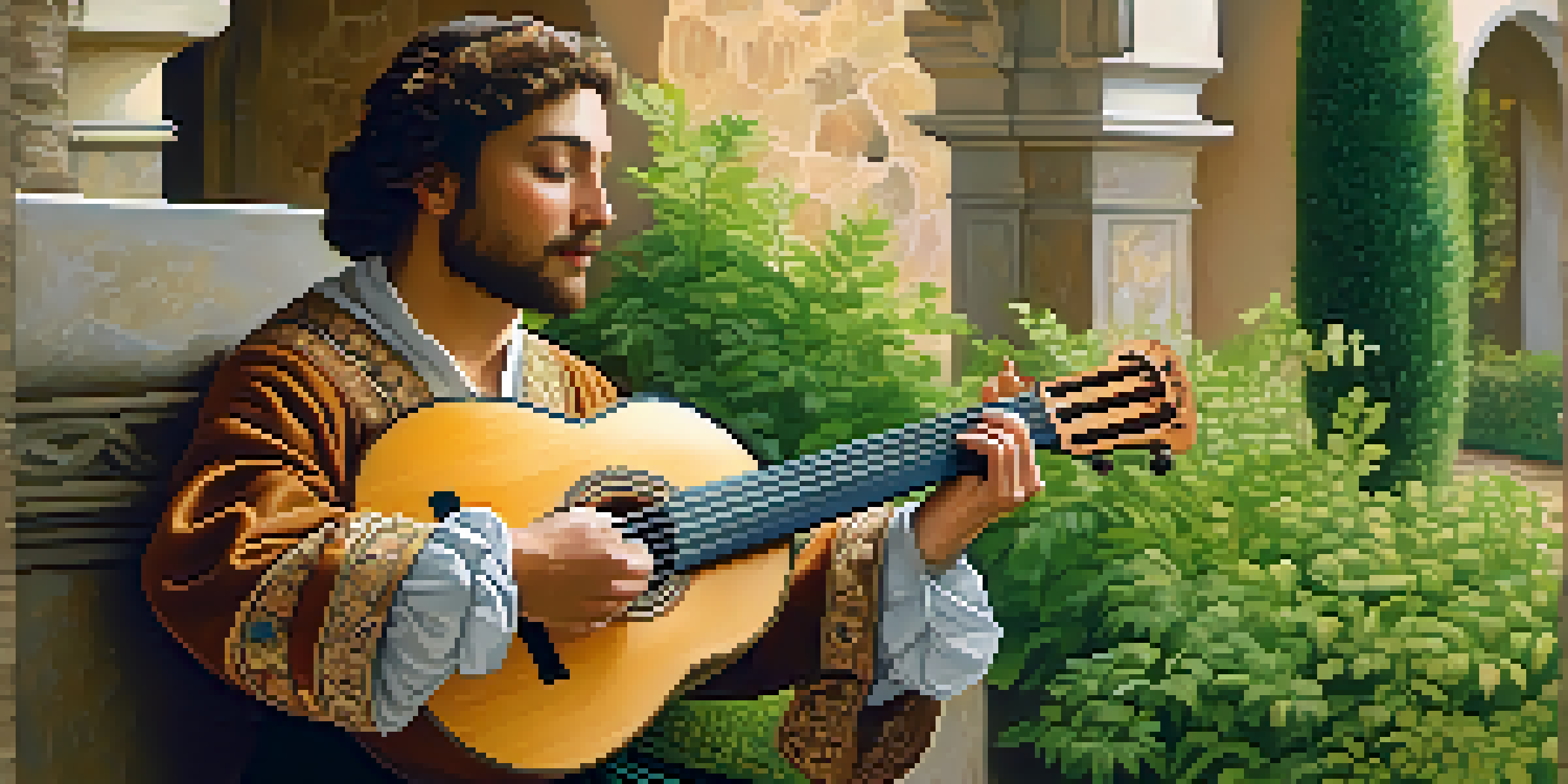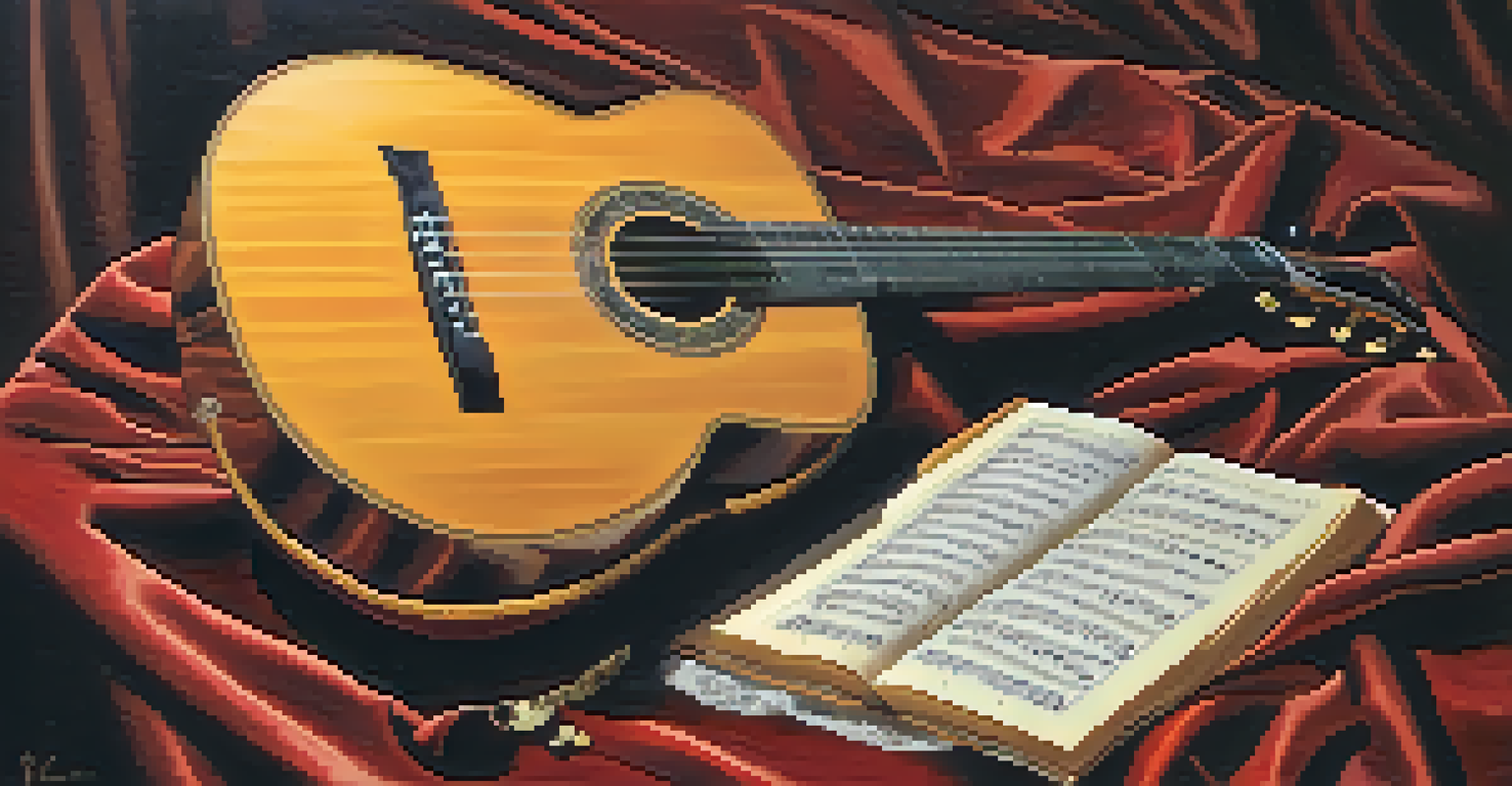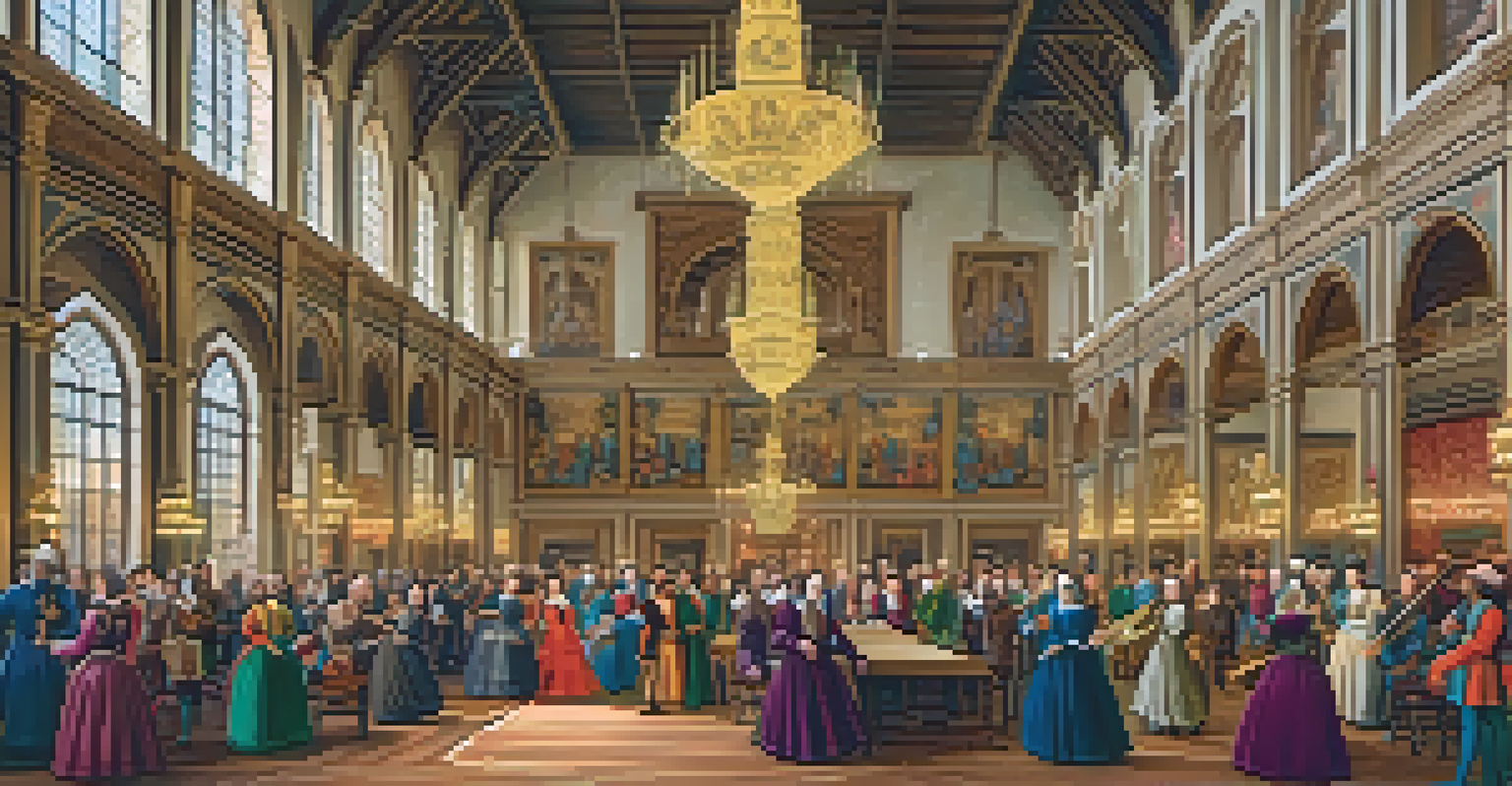How the Renaissance Shaped the Development of Guitar Music

The Renaissance: A Cultural Awakening
The Renaissance, spanning roughly from the 14th to the 17th century, was a period of profound cultural rebirth in Europe. It marked a shift from medieval traditions to a renewed interest in art, science, and humanism. This vibrant environment fostered innovation and creativity, significantly affecting various artistic expressions, including music. As people began to explore their individuality, the foundations were laid for new musical forms and instruments, including the guitar.
The Renaissance was a time of great change and innovation, where art and music flourished in an environment rich with new ideas.
During this time, musicians started experimenting with different styles, incorporating elements from various cultures. The rise of secular music, alongside sacred compositions, allowed for a broader range of expression. This cultural shift opened the door for the guitar to emerge as a prominent instrument, as it became associated with both folk traditions and refined compositions. The fusion of old and new ideas during the Renaissance created fertile ground for the guitar's evolution.
Moreover, the Renaissance's emphasis on education and the spread of knowledge through the printing press played a crucial role in the development of music. Composers could now share their works more widely, leading to increased collaboration and the exchange of ideas. This interconnectedness set the stage for the guitar to flourish, as musicians sought to create new sounds that reflected the dynamic spirit of the time.
The Emergence of the Lute and Its Influence
One of the key instruments of the Renaissance was the lute, which played a significant role in shaping early guitar music. With its delicate sound and intricate fingerwork, the lute became a favorite among musicians and composers. As the lute's popularity soared, it influenced the design and playing techniques of the guitar. The transition from lute to guitar was gradual, but essential for the instrument's development.

Lutenists often composed pieces that were later adapted for the guitar, creating a repertoire that bridged the two instruments. This exchange allowed guitarists to learn from the rich musical traditions of lute playing, incorporating ornamentation and melodic structures into their performances. As a result, the guitar began to gain its own identity while still retaining elements of its predecessor, which enriched its musical vocabulary.
Renaissance Sparked Musical Innovation
The Renaissance era fostered a cultural rebirth that paved the way for new musical forms, including the emergence of the guitar.
Additionally, the lute's prominence during the Renaissance helped pave the way for the guitar's acceptance in both aristocratic and popular music circles. The blending of styles and techniques encouraged musicians to experiment further, leading to the evolution of guitar music. By the end of the Renaissance, the guitar was on its way to becoming a staple in various musical genres, thanks in part to the lute's influence.
A Shift Towards Polyphony in Music
As the Renaissance progressed, polyphony—the simultaneous combination of multiple melodies—became increasingly popular in music. This shift allowed composers to explore complex harmonies and textures, which had a significant impact on guitar music. Guitarists began to adopt polyphonic techniques, layering melodies and harmonies to create richer soundscapes. This development was crucial in establishing the guitar as a versatile instrument capable of intricate compositions.
Music is the shorthand of emotion.
One of the most notable examples of this polyphonic influence is found in the works of composers like Francesco da Milano, who wrote extensively for the lute and guitar. His compositions often featured interwoven melodies that showcased the instrument's capabilities. These intricate pieces not only elevated the guitar's status but also inspired future generations of musicians to push the boundaries of what the instrument could do.
Furthermore, the rise of polyphony encouraged collaboration between composers and performers, fostering a creative environment where new ideas could flourish. This exchange of knowledge and techniques allowed guitarists to experiment with various styles, leading to the development of unique musical forms. The embrace of polyphony marked a turning point in guitar music, setting the stage for the instrument's evolution in the Baroque period and beyond.
The Birth of the Baroque Guitar
The transition from the Renaissance to the Baroque period brought significant changes to the guitar's design and playing style. The Baroque guitar, characterized by its rounded back, was larger and had six courses (pairs of strings), which allowed for a broader range of notes and greater resonance. This evolution in instrument design reflected the changing musical landscape of the time, as composers sought more expressive tools to convey their ideas.
With the emergence of the Baroque guitar, musicians began to explore new techniques, such as fingerpicking and the use of chords in accompaniment. This shift enabled guitarists to support vocalists and other instruments more effectively, expanding the guitar's role in both solo and ensemble performances. The Baroque guitar's versatility allowed it to adapt to various musical contexts, from intimate gatherings to grand performances.
Lute's Influence on Guitar Development
The lute significantly shaped early guitar music, influencing its design and playing techniques as musicians bridged the two instruments.
Moreover, the Baroque period saw the rise of iconic composers like John Dowland and Gaspar Sanz, who further contributed to the guitar's repertoire. Their compositions showcased the instrument's capabilities and laid the groundwork for future guitarists. The evolution of the guitar during this time was not just a reflection of changing tastes; it was a testament to the instrument's enduring appeal and adaptability within the broader musical tradition.
The Role of Guitar in Renaissance Culture
The guitar's rise during the Renaissance was closely linked to the cultural shifts of the period. As society embraced individual expression and creativity, the guitar emerged as a popular instrument for both amateur and professional musicians. It became a symbol of social status and artistic expression, often associated with courtly love and romantic themes. This cultural significance helped to elevate the guitar's status in the world of music.
In addition to its romantic associations, the guitar was also a tool for storytelling and communication. Musicians would use the instrument to convey emotions, share tales, and connect with audiences. This ability to evoke feelings resonated with listeners, making the guitar a beloved choice for both personal and public performances. The instrument's capacity for expression allowed it to transcend social barriers, appealing to a wide range of people.
As the guitar gained popularity, it began to influence various musical genres, from folk to classical. This cross-pollination of styles enriched the musical landscape of the Renaissance and laid the foundation for future developments in guitar music. The cultural role of the guitar during this time was not just about entertainment; it was about creating connections and fostering a sense of community through shared musical experiences.
The Influence of Notation and Music Theory
The Renaissance was a pivotal time for the development of music notation and theory, which significantly impacted guitar music. The introduction of standardized notation allowed composers to write down their ideas more clearly, making it easier for guitarists to learn and perform new works. This advancement in music literacy was crucial for the growth of the guitar repertoire, as it enabled musicians to share their compositions with others.
Additionally, the exploration of music theory during the Renaissance helped musicians understand the relationships between notes and harmonies. Guitarists began to apply these theoretical concepts to their playing, allowing them to create more sophisticated compositions. This understanding of music theory not only enhanced the technical aspects of guitar playing but also deepened the emotional content of the music itself.
Legacy of Renaissance Guitar Music
The innovations of the Renaissance continue to inspire modern guitarists, highlighting the instrument's adaptability and timeless appeal.
As a result, the guitar became an instrument of choice for both amateur and professional musicians, who were eager to explore the new possibilities offered by notation and theory. The interplay between the evolving understanding of music and the guitar's development created a rich tapestry of sound that resonated with audiences. The foundation laid during this period would continue to influence guitar music for centuries to come.
Legacy of Renaissance Guitar Music
The impact of the Renaissance on the development of guitar music is still felt today. The period laid the groundwork for the evolution of the guitar as we know it, influencing styles, techniques, and repertoire. Musicians continue to draw inspiration from the works of Renaissance composers, incorporating their melodies and harmonies into modern performances. This enduring legacy highlights the guitar's adaptability and timeless appeal.
Moreover, the Renaissance era encouraged a spirit of experimentation that remains central to guitar music. Today's musicians often blend various genres, techniques, and cultural influences, reflecting the diversity that characterized the Renaissance. The guitar has become a versatile instrument capable of expressing a wide range of emotions, from the intricate polyphonies of the past to contemporary styles like rock and jazz.

In essence, the Renaissance not only shaped the development of guitar music but also established a framework for creativity and innovation that continues to inspire musicians around the world. As we celebrate the guitar's rich history, we can appreciate how the Renaissance set the stage for its ongoing evolution, ensuring that this beloved instrument remains a vital part of our musical heritage.